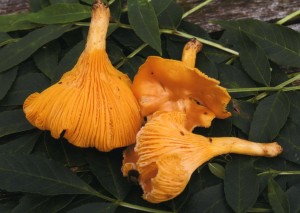With so many wild berries and nuts in short supply this year it is fortunate that the forager in the countryside can turn to what has turned out to be a bumper harvest of mushrooms. Some people refer to them as fungi and others as toadstools but mushrooms seems to be the most popular description. The only problem is one of identification and despite the plethora of books on the subject in the last few years it still leaves doubts in many people’s minds. Perhaps we should take the same approach as they do in France where the local pharmacist has qualified staff to identify mushrooms and even charts on the walls to help such identification . The practice of bringing in specimens for identification would seem to be a problem but it still seems to work. One answer is to follow the line taken by the recent book entitled “Mushrooming with Confidence” by Alexander Schwab. This book looks at the so called safe, commonly found mushrooms, with a strict guide as to their identification. For my part I just keep to the ones I know well such as chanterelles, puffballs, shaggy inkcaps and, of course, field mushrooms.
Perhaps the most obvious and outstanding mushroom this year has been the fly agaric that even seems to be relatively common on roadside verges. This spectacular mushroom is bright red, sometimes orange, and often covered in pure white spots. It is reputed to be beautiful, magical and deadly. However it is rarely poisonous and as with many mushrooms, even the so called poisonous ones, has been used for medicinal purposes. It is common and widespread in woodland such as pine and birch and, unlike most other mushrooms, is very obvious even from a distance. In contrast the small and unassuming looking puffballs are into their second growth of the season in various areas but mainly in grassland. The common puffball only grows to about 5 cms in diameter and is white and rounded with a little bump in the centre. It tends to grow in groups and the ones I kept an eye on this year ended up with twenty and these went brown and then the second ones are growing now.
 Another one in the four I look for to eat is the shaggy inkcap that is impressive as it sometimes grows in dense clusters up to 20 cms high. The other name for it is “the lawyers wig” a name which suggests easy identification but it is easy to recognise anyway. My favourite, and of many other people, is the chanterelles and the photograph is of some I picked from under birch trees. They are a vivid orange in colour and are quite striking and can grow in their hundreds. Cookery books say it is the most versatile of mushrooms and no other retains its good looks so well in cooking.
Another one in the four I look for to eat is the shaggy inkcap that is impressive as it sometimes grows in dense clusters up to 20 cms high. The other name for it is “the lawyers wig” a name which suggests easy identification but it is easy to recognise anyway. My favourite, and of many other people, is the chanterelles and the photograph is of some I picked from under birch trees. They are a vivid orange in colour and are quite striking and can grow in their hundreds. Cookery books say it is the most versatile of mushrooms and no other retains its good looks so well in cooking.
Despite their role in the “food for free” approach to the countryside we still know very little about the mushrooms of the Highlands. Recently for example there has been the suggestion that chanterelles have been changing in their distribution. It is supposed to be a mushroom that grows mainly in woodland, chiefly under oak, beech and pine. One place I found it quite common was under beech trees on the Black Isle but I have also always looked and found it under the trees in dense birch woodland in various places around Inverness. Meanwhile next time I go into Boots the Chemist I might take in a trug of mixed mushrooms and see what they have to say!
